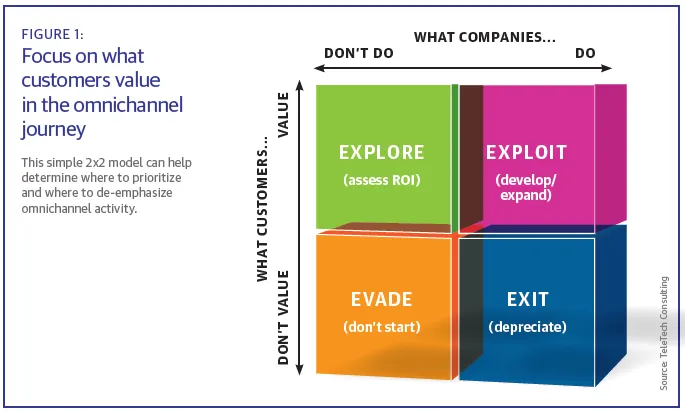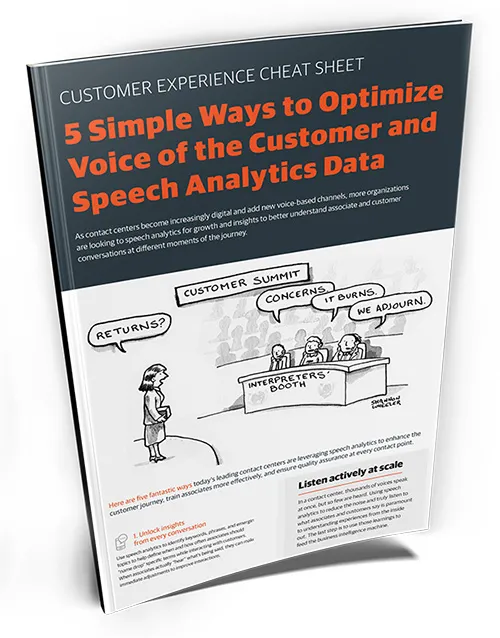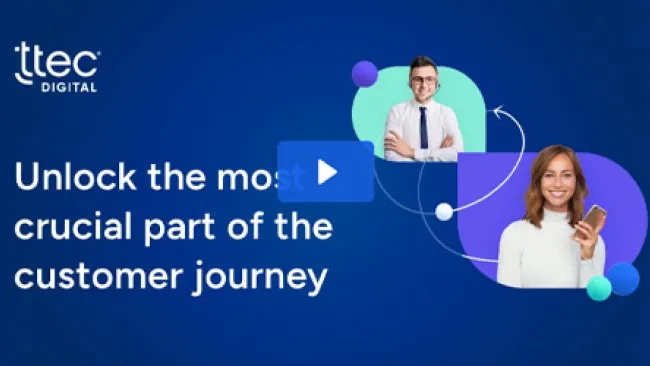Implementing a successful contact center omnichannel strategy requires the coordination of many aspects of your organization. A strong marketing technology stack and omnichannel platform, well designed intelligent routing and automation, and intuitive agent desktop and knowledgebases are all key to omnichannel success. However, one aspect that is often overlooked when operationalizing an omnichannel approach is to first ensure that your omnichannel strategy itself is optimized for success. Although many organizations talk about channel-spanning omnichannel customer experiences, few actually execute their vision in a coherent way. And even fewer deserve the distinction of being called “omnichannel.” Indeed, most companies that talk about omnichannel CX continue to focus on optimizing the customer experience within individual channels, rather than across them.
So how can your company break out of the siloes and deliver true omnichannel customer experiences across the entire customer journey? Designing a successful omnichannel strategy starts by asking the right questions. What are the common cross channel friction points? What customer expectations and preferences does your company fail to meet? What frustrations and pain points is your CX accidently creating? What blind spots in the customer journey do you have, and which are most important to fix?
The answer to these and many other pertinent questions can be found in the data that is already flowing into your call center or contact center. In this article, we talk about giving your omnichannel strategy a data twist, and show the importance of utilizing customer data to help shape and optimize your omnichannel approach.
The evolution of omnichannel strategy and customer journeys
We see omnichannel evolution occurring in three distinct stages. The first iteration, multiple-channel, occurs where two or more customer interaction channels exist, but they are not integrated. Data exists in their own silos, and it is difficult to access and act on data that lives in different departments. You know you’re a multiple channel organization if customers mention things like “you don’t remember me between visits” or “I can buy online, but I can’t exchange / return an item in-store.”
Next comes multichannel (or multi channel), where customer support channels are integrated at the data and process layer (e.g., in an electronic back office). Data about the customer is preserved and exchanged between transactions when the customer switches channels (even in mid-transaction). Diagnostically, the customer feels remembered and more valued. But, each channel looks and feels differently and is built around the underlying business process, rather than customer needs and consistency. In this model, data is more readily available, but it is still challenging to build a comprehensive picture of the customer that can be acted on holistically.
True omnichannel experiences happen when the multichannel capabilities of the organization are designed and integrated from the outside in to provide a seamless, coherent customer-centric experience; where customers use each channel when and where it suits them and can move among them with ease. This rarely happens if there is not a person or team within the organization who is tasked with optimizing customer experience or journeys.
A key enabler for multichannel and omnichannel environments is the data. Here is where the experience of working with Big Data can pay dividends. Omnichannel data will obviously come from a variety of sources and channels, and will need to be integrated and connected to form a single customer view. Of vital importance is to recognize that whilst unstructured data (text, voice, etc.) can offer real insights into customers’ feelings and motivations, it is less readily analyzed. Traditional data mining techniques need more structure, so they tend to ignore the valuable insight hidden in unstructured data. The best solutions for data management in this case are usually a hybrid of structured and unstructured databases.
Omnichannel data provides better insights into the entire customer journey across all touchpoints
What does a successful omnichannel implementation look like? How can success be measured? When it comes to data collection and analytics, it is easy to address the directly observable parts of customer engagement across channels (the actions customers take; who, what, where, when, how, how much, etc.). However, the “why” behind an action is much more intriguing and difficult to measure. It’s like cosmological dark matter—we know it’s there, but it’s not possible to directly observe it. Of course, we can use a combination of quantitative and qualitative studies to get at the causation behind the correlation, but there is a natural limit to how many times we can ask customers to rank their experience or give us a reason for why they did what they did.
The good news is that in the era of Big Data and the Internet of Things, we now have the opportunity to continuously measure what customers are doing naturally within the channels they use to interact with us. The products themselves, as well as the channels used to interact with products and services, are a wealth of real time data and information. We can then use customer lifetime journey insight and outcomes in our analysis, making more informed decisions across the organization and its channels.
Omnichannel success starts with understanding your customers and your company
In apply analytical techniques to omnichannel design and diagnosis, we are interested in two main dimensions: the things customers value from an interaction, and the things that a company does. From there, a simple model provides some very high-level indicators about where to focus omnichannel attention (see Figure 1).

What we do: It is straightforward to identify activities already underway, and use a mixture of qualitative and quantitative techniques to measure them. If we are already doing something that customers like, then keep doing it (exploit). If we are doing something that they don’t value, we then have to assess why we are doing it (for example, to meet regulatory need). When possible, we should either stop doing it (exit) or explain why it is necessary. This is the domain where analytics around observable behavior can reveal those occasions where you are theoretically delivering what the customer wants and measuring the actual impact.
What we don’t do: This assessment gets more complicated because there isn’t historical data to analyze. To use a phrase coined by Robert A. Heinlein, we need to “grok” customers—understand them thoroughly and intuitively—to learn how they use channels, and why. This means really getting to understand customers from their point of view. For example, qualitative studies such as surveys, focus groups, detailed interviews, mock-ups or prototypes, etc. can pay dividends. These studies can be analyzed with behavioral sciences like psychology to start to unlock the ‘why’ behind the ‘what’ and form workable hypotheses. In this way, we can identify new interaction opportunities and determine the activities to avoid (evade) or begin (explore).
Also, as we record and extrapolate customer needs, wants, and values, we not only start to imagine the use cases, but also the opportunities where we can subtlety influence behavior by providing a choice and measure by recording the result. For example, by tailoring when a choice is required, how to frame the options available and present it, we can guide the user toward an optimal outcome. In addition, we can identify and evaluate the intersections with our procedural needs. As we roll out our product and services we can evaluate differentiated responses with, for example, A/B tests.
Conclusion: Omnichannel customer data insights are a key omnichannel strategy
We’ve found that there are two main reasons so many businesses are interested in omnichannel. First, there is the need to integrate business around a central platform that supports improvements in efficiency and effectiveness. This indirectly influences the second reason—truly omnichannel businesses typically offer better customer service and customer experiences that in-turn improves the yield of sales and marketing efforts and results in more revenue.
As a result, true omnichannel initiatives are focused on the customer experience along the whole journey, not just on technical or process integration or a single moment in time. They should be undertaken with specific business outcomes in mind, such as increasing revenues or boosting retention, while being fully cognizant of the customer at the center. The transition to omnichannel should not be seen as a marketing-led or IT-led initiative. It should be a strategic transformation which, when properly executed, results in significant and long-lasting return on investment and happy customers.
Be careful of falling into the trap of polarized thinking about customer experience as being about either the mechanics (providing consistent, frictionless journeys) or the subjective world of emotions (how the customer feels about the journey). In the real world, we need some of both. No one is either wholly logical or wholly emotional, not even in business. We can’t force customers to feel or act in a particular way, or ignore the fact that they will have feelings and pre-existing biases. What we can do is create opportunities to be there for them, and with them, to deliver a mutually valuable experience that excites and delights.
More omnichannel strategy resources to improve customer experiences
We hope you enjoyed this article looking at the important role omnichannel customer data plays in designing, building, and implementing a successful omnichannel strategy. Whether wanting to improve an omnichannel retail experience, better understand your customers across all channels, or improve operational KPIs and customer care in your contact center, our CX and digital transformation experts can help. Here are some additional resources to help with your omnichannel strategy.
5 Ways to Create the Right Omnichannel Retail Experience: Retail is changing and leaders need to adapt. As brick and mortar gives way to e-commerce and online stores as a preferred way to shop, retailers know they need to transform their marketing initiatives and business to provide exceptional online and in store shopping experiences, But the question is how? As retailers rush to adopt digital capabilities similar to e-commerce giants, the winners of the retail throne will be customer experience leaders who prioritize the moments that matter for their shoppers. In this blog post, we look at 5 trends that are being championed by top retailers to help accelerate digital transformation.
Customer Journey Maps as a Customer Experience Tool: In this strategy guide, we explore key steps to help you understand the current state of your customer service and create an ideal future state. Learn what drives customer loyalty, better understand the current customer journey, generate new ideas to improve the journey, and make the right investments to ensure your company develops customer-focused capabilities.
Transforming Omnichannel Vision into Reality: Omnichannel orchestration is essential to provide quality customer care experiences and improve your omnichannel marketing strategy. But organizational silos, data integration gaps, and many other challenges often prevent companies from turning their omnichannel vision into reality. In this guide, learn key obstacles companies face in creating seamless omnichannel CX and best practices to overcome them, as well as examples of companies that are reaping success from their omnichannel strategies.

5 Ways to Optimize Voice of the Customer and Speech Analytics Data: In this guide, learn 5 ways to use speech analytics and call center analytics software to augment employee experience on the floor and customer experience over the phone. Today’s leading contact centers leverage speech analytics technology to enhance customer experience, train associates more effectively, and ensure quality assurance (QA) across all channels and at every contact point. Leverage speech analytics technology more effectively to better understand associate and customer conversations across the entire journey.
Voice of the Customer Strategy and Best Practices: Most customer experience leaders say they have active voice of the customer (VOC) programs in place. They track NPS, ask customers to complete post-interaction surveys, and employ speech analytics. But too often they are not really listening. Gain valuable insights about your products and services by implementing these five best practices for customer feedback. Also learn about customer data analytics complications that hinder voice of the customer program implementation and how to overcome them.
Unlock Customer Insights Hidden in Plain Sight: Customers have multiple contact options today beyond just voice calls. IVR, online self-service, virtual assistants, live chat, online forums, mobile apps, social media, and more. Chances are, you’re not optimizing the customer insights living in your contact center and beyond, across all of these touchpoints. In this strategy guide, we explain how businesses can combine existing data from multiple sources and start applying customer insights to deliver personalized and engaging customer experiences and operational objectives.
Channel Orchestration: Make Your CX Efforts Sing: Mobile apps, social media, voice calls, self-service, chat, messaging on mobile devices, in store, and more, Online and offline, there are now so many ways for a customer to interact with a brand, and true channel orchestration requires a full view of the customer journey so you can create seamless experiences. In this Strategy Guide, our omnichannel strategy experts outline 4 keys to successfully orchestrating customer data and the user experience across multiple channels in order to make your CX sing.
Be Proactive with Speech Analytics for Sales: Speech analytics is an invaluable tool that can help your sales team better understand the phrases, trends, and sentiment behind ever successful interaction. That's why it's up to your organization to use speech analytics to drive sales revenue and create moments that truly matter with your customer.















